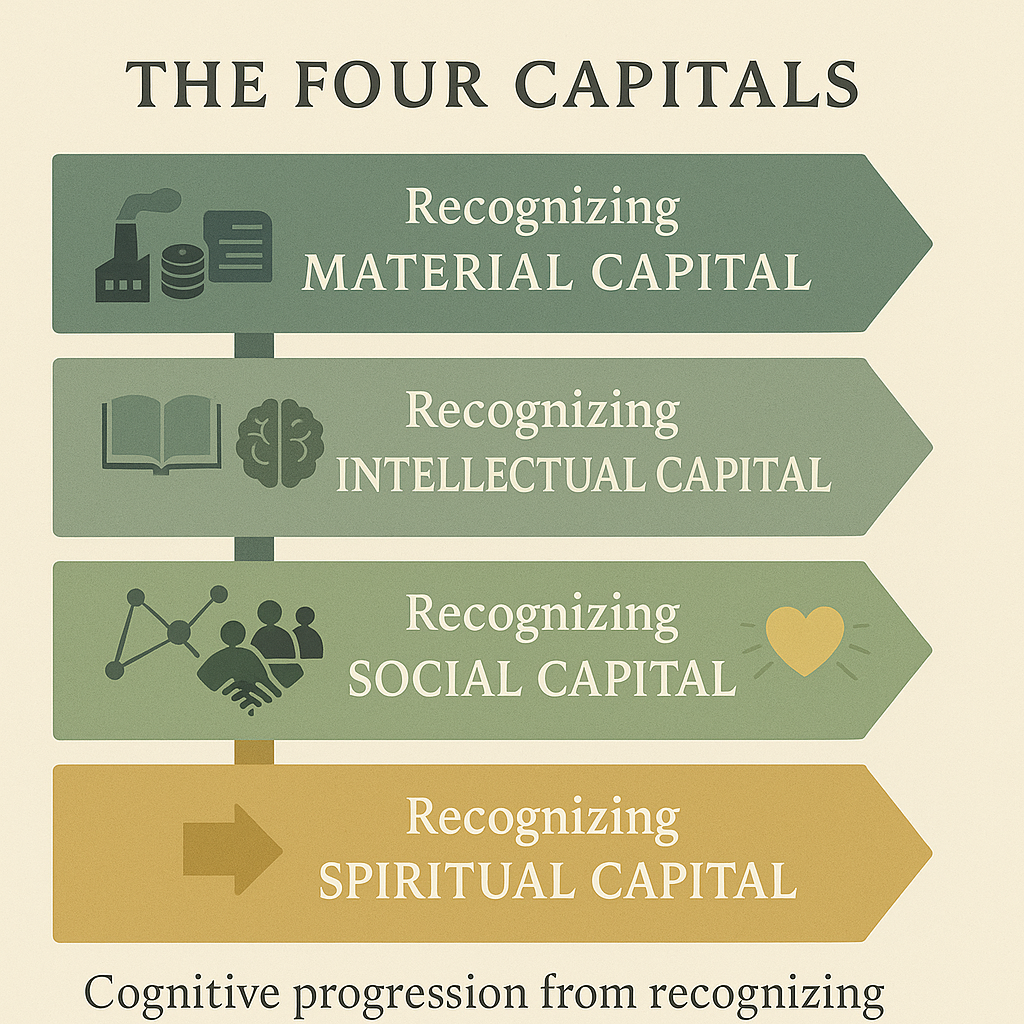|
Chapter 1: Evolution of Capital
 The meaning
of “capital” has evolved from a strictly economic or financial term
to include intellectual, social, and spiritual dimensions. This
broader view reflects how value is created and sustained in modern
life. Below is a brief historical review and a simple framing for
today. The meaning
of “capital” has evolved from a strictly economic or financial term
to include intellectual, social, and spiritual dimensions. This
broader view reflects how value is created and sustained in modern
life. Below is a brief historical review and a simple framing for
today.
Material or
Economic Capital. Traditionally, capital meant material or economic
wealth. It referred to tangible assets like money, land, equipment,
and other resources used to produce goods and services. This view,
grounded in classical and neoclassical economics, dominated through
the mid-20th century.
Today’s
note: material capital also includes critical infrastructures such
as energy, transportation, digital networks, and even computing
capacity—foundations that enable all other activity.
Intellectual Capital. As knowledge-based economies rose in the late
20th century, intellectual capital gained prominence. It captures
how knowledge, skills, and innovation drive growth and
competitiveness. Intellectual capital is often described in three
parts: human capital (people’s skills, knowledge, experience),
structural capital (processes, data, software, and systems), and
relational capital (customer and partner relationships). Pioneers
such as Peter Drucker and Thomas A. Stewart helped popularize this
concept.
Today’s note: data,
software, and AI models have become core intellectual assets,
alongside education, research, and everyday learning.
Social
Capital. Social capital came to the fore in the late 20th century
through the work of scholars like Pierre Bourdieu and Robert Putnam.
It refers to networks, norms of reciprocity, and trust that help
people coordinate and act together for mutual benefit. Social
connections—within teams, across communities, and between
institutions—carry real value.
Today’s note: online and offline networks shape opportunity and
resilience. Bonding ties build reliability; bridging ties open
access to new ideas and resources.
Spiritual
Capital. The newest addition is spiritual capital. It highlights
resources drawn from spiritual and religious beliefs, practices, and
traditions that support well-being and constructive action. For
people of faith, it can be a sense of connectedness with God. For
others, it can be commitments to noble purposes, ethics, and
meaning. Authors such as Danah Zohar have explored and advanced this
concept.
Today’s note: purpose,
values, and moral standards translate into habits and choices; when
these guide behavior, they form usable capital for individuals,
organizations, and societies.
Taken
together, these shifts expand capital from purely financial assets
to a more holistic set of resources—material, intellectual, social,
and spiritual—that contribute to personal and societal well-being.
Not all value is tangible, and not all capital is measured in money.
Note: The work
presented here includes research conducted by Dr. Alex Liu at
Stanford University and that for the Global Entrepreneurship
Monitoring initiative. Dr. Alex Liu greatly benefited from valuable
discussions with several accomplished authors, including Danah
Zohar, author of 'Spiritual Capital'; Ernie Chu, author of 'Soul
Currency'; Theodore Roosevelt Malloch, author of 'Spiritual
Enterprise'; and Lawrence M. Miller, author of 'The New Capitalism'.
Note:
To cite us, please write "Liu, Alex. 4Capital and
Performance, RM Publishing, 2008, ResearchMethods.org,
https://www.researchmethods.org/4capital.htm.
|